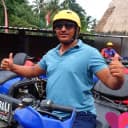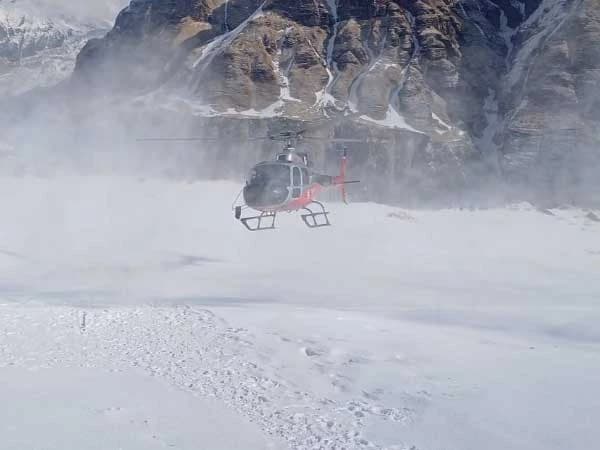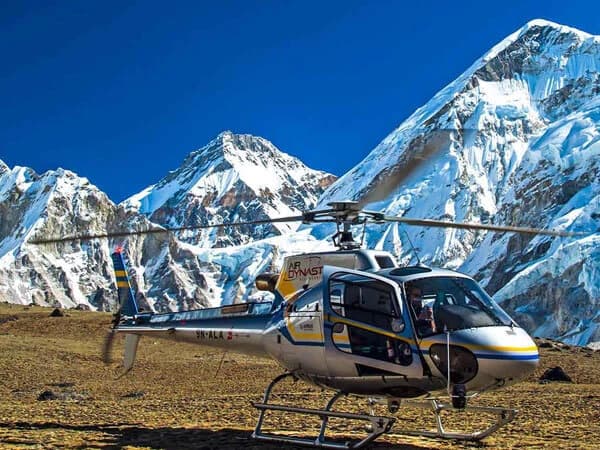Photo Opportunities During the Everest Base Camp Helicopter Tour
Everest Photography Helicopter Tour package offers an extraordinary opportunity for photographers to capture some of the most spectacular and iconic views on earth. The journey holds limitless photography possibilities from start to finish. From the moment helicopter leaves Kathmandu, you are treated to the ever changing panorama of rolling green hills and terraced fields to startling rise of snow topped mountains. All these make for wide angle landscape shots.
During a brief stop at Lukla Airport, one of the globe's most famous high altitude airfields, photographers can snap the unique environment of mountain village and Sherpa style homes. The helicopter flies over the Sagarmatha National Park with alpine diversity in abundance. Depending on season, you can photograph rhododendron woods in full bloom or see yaks grazing on hilltop pastures.
While helicopter makes its ascent to Kala Patthar, you can capture all the more stunning pictures of dramatic landscape formations in form of glaciers, icefalls, rugged valleys, sprawling crevasses and Himalayan giants. Arriving at this alpine viewpoint, you will have chance to disembark at over 5,500 meters and experience the sheer, unadulterated beauty of the Himalayas firsthand.
The flyover by helicopter over Everest Base Camp provides unconventional bird's eye views and breakfast stop at Everest View Hotel lets you capture mighty snow capped peaks strikingly framed against blue skies. On the way back to Kathmandu, you will have final aerial vistas of varied landscapes from snowy summits to bottomland valleys. All in all, this tour provides an unparalleled photography experience for nature lovers, adventurers and professionals alike.

Photography Gear for Everest Helicopter Tour
Documenting the glory of the Everest region requires not just skill but appropriate gear. Since there is limited room within the helicopter and the weather may change suddenly, it is essential to plan sensibly for your photography tour. These are some of the best recommended photography gear for the Everest Base Camp helicopter tour.
DSLR or Mirrorless Camera
A lightweight, high quality camera is ideal for helicopter tours. Mirrorless cameras are especially well suited for travel due to their compact size and better image quality.
Lens
A wide angle lens of 6–35mm or a 24–70mm lens is perfect for wide shots of the majestic Himalayan landscapes. Likewise, a telephoto lens is important to zoom in on distant peaks or cultural heritages or villages from an aerial vantage point, a 70–200mm lens or similar can be very useful.
Extra Batteries
Cold weather at high altitudes can cause batteries to drain quickly. Pack a minimum of 2–3 fully charged spares.
Memory Cards
Bring a few high capacity memory cards. Shooting in RAW format gives you higher quality images for editing later, but it also takes up more storage space.
Polarizing Filter
The polarizing filter helps remove glare and increase contrast in bright lighting conditions. It is handy to have while shooting snow capped peaks or blue skies.
Camera Strap
A good strap helps to avoid any such unexpected drops of the camera inside the helicopter, especially while changing lenses quickly.
Lens Cleaning Kit
Wind and cold can cause condensation or allow dust to enter the lens. A blower and a microfiber cloth can keep your camera lens clean during the shoot and resulting in clear pictures.
Tripod (Optional)
While it cannot be used inside the helicopter, it might prove useful on ground stops like at Kala Patthar or Everest View Hotel.
Protective Camera Bag
Bring a weather proof padded bag for your camera gear to protect it from bumps, cold and sudden weather changes.
Protecting Your Photography Gear From Cold Weather
High altitude weather is cold, which speeds up battery discharge, so take 2–3 spares and keep them in warm inner pockets to ensure better performance throughout the tour. Condensation is another problem that may occur when changing from warm to cold environments. Take lens cloths and a blower brush to gently remove any moisture or mist. Your gear should be nicely wrapped in a padded, weather proof case, and make sure your camera strap is kept tight at all times.
Safety Considerations During the Everest Base Camp Helicopter Tour
- Walk slowly at high altitude landing points such as Kala Patthar and Hotel Everest View. This helps to avoid altitude sickness.
- Drink a lot of water. Refrain from heavy foods and alcohol.
- Follow instructions of pilot or guide on safety and emergency procedures.
- Take medication before flight if you are prone to motion sickness.
- Do not spend much time outside of helicopter at high altitude if you are feeling cold and uncomfortable.
- Temperatures are considerably lower at high altitudes. Wear layers to stay warm and adjust to weather variations.
- Sunglasses and sunscreen are a must due to high UV radiation at alpine altitudes.
Best Time for Everest Photography Helicopter Tour

The ideal time of year to take Everest Photography Helicopter Tour is during the clear weather seasons. They are spring (March, April, May) and autumn (September, October, November).
Spring brings mild temperatures, stable weather and excellent visibility. It adds diverse color to your images with wildflowers in bloom, mountains in white snow, green valleys and blue skies. Moreover, sparkling glacial streams and active wildlife are other photography themes during this time.
After the monsoon, autumn invites cool and fresh air. This gives you crystal clear views of the Himalayas. The crystalline skies and soft golden light in the morning allow for dramatic shots of snow capped mountains. Since the weather is most stable during this time, chances of flight cancellations are also significantly reduced.
Furthermore, autumn coincides with Nepal's grandest festivals like Dashain and Tihar. It adds a cultural spice to your vacation. And you will have chance to capture rich local celebrations against breathtaking Himalayan backdrops.
Winter (December, January, February) gives good visibility of the Everest region. It is draped in fresh white snow. This time is ideal to capture the magnificent winter wonderland of this classic Himalayan destination. However, it is considerably colder and snowfall could affect helicopter landing.
On the other hand, summer/monsoon (June, July, August) is worst due to cloud cover, poor visibility and frequent weather interferences. So, it is better to avoid this time for your Everest Photography Helicopter Tour.
Best Time of the Day
Early morning is best for a helicopter photography tour of Everest region. At this time, air is generally clearer, winds are lighter and light is softer with enhanced contrast and depth in your pictures. This golden hour lighting beautifully illuminates snow covered mountains and throws dramatic shadows on ridges and valleys. Noontime sun is stronger and can blush or even wash out details out and afternoons will be cloudier with less stable air. For best photo clarity and camera performance, try to schedule your flight between 6:00 and 9:00 AM.
What Is So Special About This Tour?
Everest Photography Helicopter Tour is an exceptional way of capturing the breathtaking Himalayas in world renowned Everest region from an aerial perspective. In contrast to days long trekking and excess physical stamina, this tour makes Everest region accessible to everyone be it photographers, nature lovers, adventurers or amateur travelers alike.
This helicopter tour brings you close to several iconic sites within a single day, like Lukla, Sagarmatha National Park, Everest Base Camp and Kala Patthar. The bird's eye angle of these gratifying landscapes from vantage point of a helicopter reveals intricate glacier patterns, crevasses, alpine woodlands and widescreen Himalayan vistas to capture in your lens.
Aerial Photography Tips
- Use a fast shutter speed to prevent motion blur in pictures due to helicopter movement.
- Shoot in bursts to optimize chance of getting sharp and well composed photos.
- Use a wide angle lens for landscape shots and a telephoto for distant peaks or to take close details.
- If you are new to photography, consider hiring professional guides or photography tutors. They will help you get best photo shoots.
- Don't use flash and shoot through reflective glass.
- Adjust your camera settings prior to your tour. Have a good camera strap or harness to prevent it from falling unintentionally.
- Plan your tour in spring or autumn to have best skies and optimal visibility.
- Fly in mornings to take advantage of light winds and cloudless skies. This allows for optimal flying and better photography possibilities.
- Bring minimum gear to maintain weight on luggage since helicopter has limited space.
- Photography is main purpose. But do not forget to enjoy gorgeous views and unique atmosphere of Everest region.
- Cold and wind can make your lens covered with moisture and dust. Have a microfiber cloth and a lens blower for immediate cleaning.
- Shoot in RAW mode to have more room for editing.
- Make sure your camera batteries, phone and other electronics are fully charged before tour.
- Cold weather drains batteries faster. And RAW images take up more storage space. So carry
- Understand itinerary and key landmarks. This helps you anticipate photo opportunities and be ready when moment arrives.
- While traveling to villages or monasteries, get permission before photographing people or religious properties.
- Carry a heavy duty, weather resistant camera bag to protect your gear.
- Use a polarizing filter to dampen glare due to ice, sun and snow. It also adds richer color and contrast to your photos.
If you are around Pokhara, you can choose Annapurna Base Camp helicopter tour or Annapurna Base Camp trek as an alternative.














